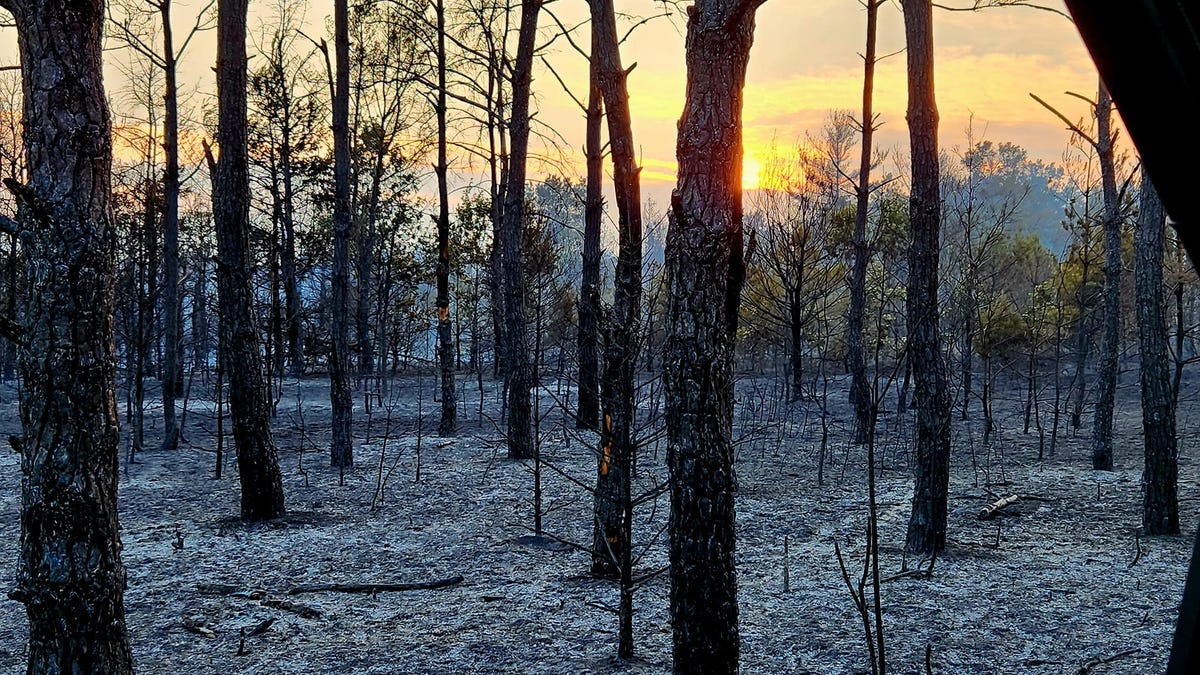Wisconsin’s wildfire season is starting fast and early across the state after a warm, dry winter.
A March wildfire outlook report from the National Interagency Fire Center, or NIFC, shows that the majority of Wisconsin — virtually all of it except a small slice of the southeastern part of the state that includes Milwaukee — is in “above normal” potential for wildfires through March and April.
And with winter not delivering heavy snowfall or temperatures needed to sustain snowpack throughout the state, it has meant that the state is seeing far more fires than usual by this time of year. The state Department of Natural Resources responds to and tracks wildfires in the state and in 2024 there’s been 196 fires across 361.43 acres, as of March 12.
Across the last 10 years, there’s typically 16 fires across 16.24 acres by that date. And, in the last week, there’s been 50 fires alone, the department announced March 12.
“We are significantly ahead of that and most of that is due to the lack of snow,” said Marc Sass, a state Department of Natural Resources cooperative area forest ranger in southeast Wisconsin. “Basically, there is no area of the state with snow … we’re at least one month ahead of where we typically are.”
Sass said it’s the first time in his 10 years at the agency that he’s noticed the lack of snow throughout the entire state. The lack of snow means that fuel, like dead grasses or other plants, are ready to burn earlier than usual and before the plants grow back in the spring.
The NIFC report says that the Eastern Area of the nation, which includes Wisconsin and the Great Lakes region, is facing heightened risk due to long-term drought, a lack of precipitation throughout February and the lack of snowpack.
“Exposed fine fuels and tall grasses that were not compressed under snow have become available to burn,” the report reads. “Hot, dry, windy events and persistently strong winds will be a big determinant in both the potential for increased and significant fire activity during the outlook period.”
The report says that Wisconsin chould be at a normal fire risk by May.
Wildfire season comes early, all at once
In Wisconsin, almost the entire state has entered wildfire season at once this year.
In most years, Sass said the state has what is effectively a rolling start. As the southern half of Wisconsin thaws and enters fire season by late February or early March, the upper half is usually not in conditions for it until April. In 2024, the state Department of Natural Resources has battled fires as far north as Douglas and Ashland counties.
“It limits how much we can shift our resources,” Sass said of the wide range of fires. “Typically, when the southern areas are snow-free and we’re having fires and actively suppressing fires … we often bring northern (help) down.”
The bright side, as the NIFC report notes, is that areas could see an early green up, when grasses return after the winter, and lead to a fire season ending earlier.
Steve Marien, a fire meteorologist at NIFC, said that while the potential is higher than typical, it doesn’t necessarily mean there will be rampant fires or particularly large ones this year. That still depends on day-to-day weather patterns, like high winds or heat, which could influence whether fires begin and their size.
However, he said that a possible issue is the potential for numerous small fires, which can put stress on fire departments spread thin.
Another factor is the state’s ongoing drought from last year, said Steve Vavrus, Wisconsin’s state climatologist and the assistant director at the University of Wisconsin Madison’s Center for Climatic Research.
About 68 percent of Wisconsin is in a drought, according to the latest data from the United States Drought Monitor. With 18.5 percent in a “severe drought” or a level two out of four.
“The concern right now, is that we’re in a drought still from last year. In fact, the drought conditions have worsened quietly in the last few weeks,” Vavrus said. “If we get a few more of the really unseasonably warm days that we had (earlier this month) … there’s legitimate concerns surrounding the higher risk of fire in Wisconsin and elsewhere.”
Historically Wisconsin is not ripe for large wildfires compared to other states, especially those in western parts of the country, Vavrus said. However, warm and dry conditions have caused issues here too.
In 2021, wildfires in Wisconsin prompted a state of emergency in the state. Last April, dry soil and temperatures in the 80s led to wildfires in the state and he pointed to another fire near the Necedah Wildlife Refuge in central Wisconsin in 2020.
Wisconsin’s heightened fire concern comes as other parts of the country have experienced massive blazes and worries simmer in Canada. In Nebraska, a massive fire burned over 71,000 acres and an ongoing wildfire in the panhandle of Texas is the biggest in history for that state.
On Monday the local National Weather Service issued a statement warning of elevated fire weather conditions in southern Wisconsin and cautioned people burning to take caution, due to the chance it could quickly spread. In worse conditions, the organization will issue a red flag warning and parts of neighboring states like Illinois and Minnesota have issued them in the last week.
The Canadian province of Alberta’s government declared a 10-day early start to its 2024 wildfire season, due to a warm temperature and lack of precipitation.
Last year, wildfires in Canada affected Wisconsin due to heavy smoke drifting to the United States. This year, there’s potential for wildfires to be an issue there again. National outlets like the New York Times have noted that some fires from last year, dubbed zombie fires, are still smoldering in Canada.
“Snowpack like in south central Canada is below normal up there too. So that’s problematic. Is it going to be as bad as last year? A lot of those starts are lightning starts from storms, it’s all dependent on if they get ignitions,” the fire meteorologist Marien said.
El Nino, climate change having an impact
A major factor in this year’s early start to wildfire season is the El Nino effect occurring and leading to the warmest winter on record. It typically reduces snowfall totals in Wisconsin.
El Nino can often mean a wetter season, with precipitation up two inches on average, according to the National Weather Service. However, this year, that was not borne out.
The organization reported that precipitation was down in both Milwaukee and Madison. In Milwaukee, the area typically sees 37.1 inches of snowfall, but that was down 17.6 inches this winter.
Knowing this year was going to be an El Nino year, the DNR has been on alert for this year’s fire season, Sass said.
“When we come through an El Nino winter, we expect more fires than we would in typical winter seasons,” he said.
Even if El Nino had brought an increase in rain, which is some help, the loss of snowpack has more of an impact.
Snowmelt can help stave off fire conditions across lengthy periods of time, as it melts on sunny days, refreezes overnight and repeats until it’s gone, whereas rain will soak into the ground in a day or two, Sass said.
“Every single day that it’s melting, it releases to keep that fuel wetter,” he said.
Climate change in Wisconsin is playing a role as well, as data shows that the state is becoming warmer and wetter over time, said state climatologist Vavrus.
The warmth is contributing to a faster transition between winter to summer, particularly when paired with El Nino this year. It can also melt snowpack faster.
“Both of those things can speed up the initiation of wildfire season here,” he said. “You think about a snowy cold March, we’re not going to worry about wildfires.”
After winters like the most recent and more anomalous weather overall, Vavrus said the public is starting to be more aware of climate change’s impacts in the state.
“It means it’s something we cannot ignore anymore and it’s going to become harder and harder to ignore,” Vavrus said.

































